Here are 10 things you should know about Eddie Bracken, born 109 years ago today. In a career of more than 70 years, he worked in vaudeville, films, radio, Broadway and television.
Tag: The Seven Year Itch
10 Things You Should Know About Donald MacBride
Here are 10 things you should know about Donald MacBride, born 130 years ago today. The snaggle-toothed character actor was ubiquitous in the films of the 1930s and ’40s.
Happy 124th Birthday, Donald MacBride!
A familiar face to old-movie buffs, snaggle-toothed character actor Donald MacBride was born 124 years ago today in Brooklyn, New York. He began his career in his teens as a singer, making several records in 1907 before moving on to vaudeville and eventually Broadway, motion pictures and television.
MacBride appeared in more than 30 short subjects from 1914 to 1916, the year he made his first feature-length picture. All totaled, he appeared in more 140 motion pictures, frequently played cops, police detectives and hotel detectives—sometimes playing it straight and plenty tough, but often, in comedies such as the Marx Brothers vehicle Room Service (1938), The Gracie Allen Murder Case (1939), My Favorite Wife (1940) and Topper Returns (1941), his authority figures were frazzled, frustrated and confused. His last movie appearance was in The Seven Year Itch (1955).
MacBride made his television debut with a recurring role on My Friend Irma in 1952. He would continue working on the small screen until his death, appearing on such programs as My Little Margie, The Ray Milland Show, The Jimmy Durante Show and The Ford Television Theatre.
MacBride, a veteran who saw active duty overseas during World War I, died in 1957. He was survived by his wife, Esther, whom he marred in 1930.
Happy birthday, Donald MacBride, wherever you may be!
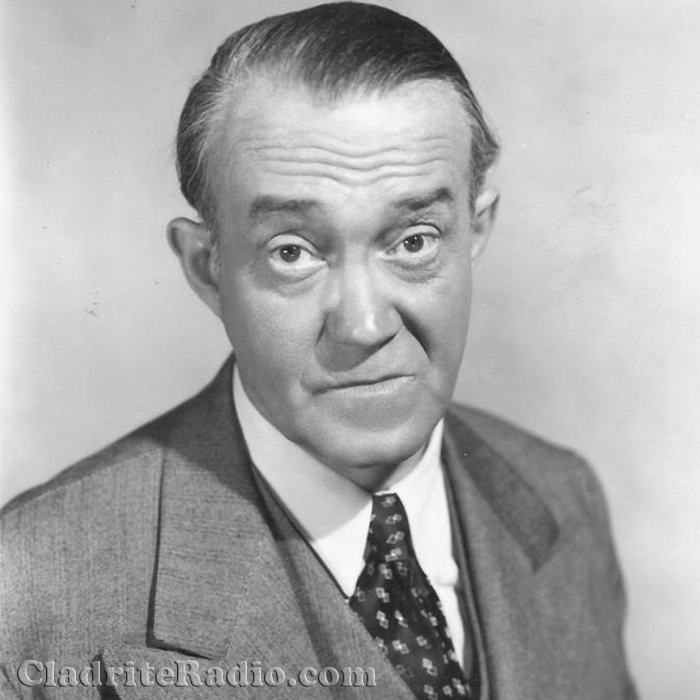
Norma Jean in New York
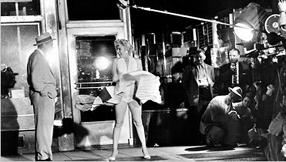 Marilyn Monroe is, quite naturally, most strongly associated with Hollywood, but she spent time in New York City, too.
Marilyn Monroe is, quite naturally, most strongly associated with Hollywood, but she spent time in New York City, too.
After all, her two husbands, Yankees outfielder Joe DiMaggio and playwright Arthur Miller both had strong New York connections, and she studied acting for some time with Lee Strasberg.
And then there’s her iconic role in Billy Wilder‘s The Seven Year Itch, which takes place in New York City (though most of it was filmed out west).
Pat Ryan, in a story in today’s New York Times, offers a Monroe mini-tour, with addresses and locales that were key to Monroe’s time in NYC, including the subway grate, over which her skirt was famously blown up in the aforementioned Seven Year Itch, the townhouse seen in that film in which her character and Tom Ewell‘s married but restless book editor both resided, a venerable dive bar on the East Side that she is said to have patronized, and a dozen other museums, business establishments and residences where Monroe spent time.
EDIT: After posting the above, we came across the blog Letteryheady, which features letterheads and stationery of the rich and famous. Among the letterheads featured is one for Marilyn Monroe Productions, Inc., which seems to have headquartered out of the apartment Monroe shared with her then-husband, the aforementioned Miller. That seems a bit odd.
But there’s one little tidbit of additional info found on that piece of stationery: a phone number. I don’t know if it was Arthur and Marilyn’s personal number, or if they had a second number added to serve as a business number, but here’s a dandy little item to add some cachet to your little black book: Marilyn Monroe’s phone number was once ELDORADO 5-2325.
Covering all the bases
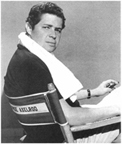 Most folks who know George Axelrod remember him for his play (and the movie Billy Wilder made from it), The Seven Year Itch.
Most folks who know George Axelrod remember him for his play (and the movie Billy Wilder made from it), The Seven Year Itch.
But his career took many turns. After a stint in the Army Signal Corps during World War II, the native New Yorker found gigs writing for radio and contributed material to comedians, including Martin and Lewis, before hitting it big on Broadway and moving on to write for television and motion pictures (he wrote the screenplays for Phffft!, Breakfast At Tiffany’s, and the original version of The Manchurian Candidate, among many others).
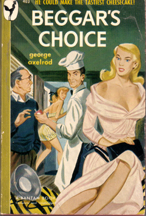 Axelrod also authored three novels: Beggar’s Choice (1947), a role-reversal comedy that finds a novelist whose racy tome gets banned in Boston and New York turning instead to domestic service when he is hired to cook for a well-to-do Connectict family, and his wife takes on chauffeur duties, Blackmailer (1952), a hardboiled mystery set in the world of New York publishing, and Where Am I Now When I Need Me? (1971), a farce that skewers both the publishing industry and Hollywood.
Axelrod also authored three novels: Beggar’s Choice (1947), a role-reversal comedy that finds a novelist whose racy tome gets banned in Boston and New York turning instead to domestic service when he is hired to cook for a well-to-do Connectict family, and his wife takes on chauffeur duties, Blackmailer (1952), a hardboiled mystery set in the world of New York publishing, and Where Am I Now When I Need Me? (1971), a farce that skewers both the publishing industry and Hollywood.
We’ve read about a quarter of Axelrod’s first two titles. We started Beggar’s Choice a few months back and put it aside not because we didn’t find it engaging, but because some title or other we’d placed on hold at the library finally arrived, and we had to undertake that one instead. We’ll definitely return to Axelrod’s first novel, though we’re not prepared to say just when.
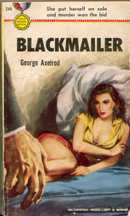 And a just an hour or so, while enjoying the beautiful spring weather in Union Square Park, we ripped through the first forty pages of Blackmailer (which was reissued not long ago by Hard Case Crime — a publishing house of which we are big supporters — though we were reading the original edition pictured here), which is a snappy thriller involving one Richard Sherman, a partner in a low-rent publishing concern that survives mostly on the sales of crosswod puzzle books whose life is turned upside down when a beautiful dame turns up in his office offering to sell him the final completed work by a hot-shot author who died just months before. Trouble is, she’s not exactly forthcoming about how she got her hands on this desirable piece of goods, and his company is not exactly the kind of house that would generally have a shot at publishing such a hot — in every sense of the word — property.
And a just an hour or so, while enjoying the beautiful spring weather in Union Square Park, we ripped through the first forty pages of Blackmailer (which was reissued not long ago by Hard Case Crime — a publishing house of which we are big supporters — though we were reading the original edition pictured here), which is a snappy thriller involving one Richard Sherman, a partner in a low-rent publishing concern that survives mostly on the sales of crosswod puzzle books whose life is turned upside down when a beautiful dame turns up in his office offering to sell him the final completed work by a hot-shot author who died just months before. Trouble is, she’s not exactly forthcoming about how she got her hands on this desirable piece of goods, and his company is not exactly the kind of house that would generally have a shot at publishing such a hot — in every sense of the word — property.
What’s more, a big theatrical agent has contacted him via the mail, offering to sell Sherman the same book. Whom to believe?
Things go from bad to worse when a couple of tough guys show up at Sherman’s apartment, subjecting him to a thorough beating and breaking apart or cutting to shreds every single one of his possessions that could possibly be hiding … well, hiding what? The author’s manuscript? They don’t say (they’re not talkative types).
As we said, we’re about forty pages in — a quarter of the way through this quick pulpy read — and we’re sufficiently hooked to stay with it till the big finish (it’s a reasonably safe assumption that there will be a big finish).
We find the disparity between these two covers striking, don’t you? You’d never guess, to look at them, that they were written by the same author.
